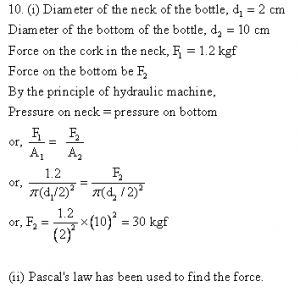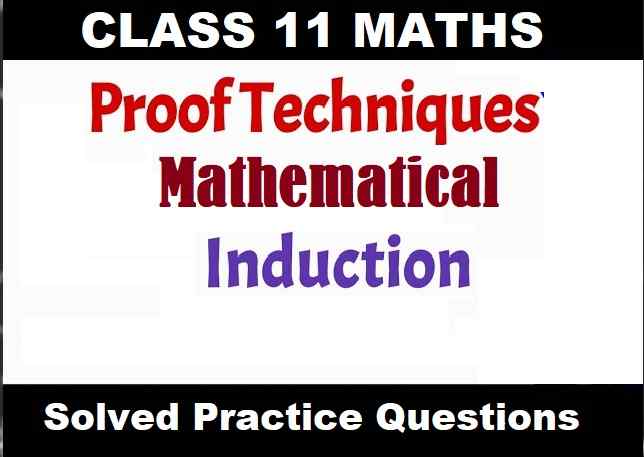Pressure in Fluids and Atmospheric Pressure Exe-4A Pressure in Fluids and it’s Transmission Numericals Answer Type for Class-9 ICSE Concise Physics. There is the solutions of Numericals Answer type Questions of your latest textbook which is applicable in 2023-24 academic session. Visit official Website CISCE for detail information about ICSE Board Class-9.
Pressure in Fluids and it’s Transmission Exe-4A Numericals Answer
(ICSE Class – 9 Physics Concise Selina Publishers)
| Board | ICSE |
| Class | 9th |
| Subject | Physics |
| Writer / Publication | Concise selina Publishers |
| Chapter-4 | Pressure in Fluids and Atmospheric Pressure |
| Exe – 4A | Pressure in Fluids and it’s Transmission |
| Topics | Solution of Exe-4(A) Numericals Answer Type |
| Academic Session | 2023-2024 |
Exe-4A Pressure in Fluids and it’s Transmission Numericals Answer Type
Ch-4 Pressure in Fluids and Atmospheric Pressure Physics Class-9 ICSE Concise
Page 103
Question 1. A hammer exerts a force of 1.5 N on each of the two nails A and B. The area of cross section of tip of nail A is 2 mm2 while that of nail B is 6 mm2. Calculate pressure on each nail in pascal.
Answer:
Given:
Force acting on nail A is 1.5N, area = 2mm2
Expressing 2mm2in metre
1mm=0.001m,
∴ 1mm2= 1mm x 1mm = 0.001m x 0.001m = 1 x 10-6 m2
Pressure on B = Force/area
= 1.5/( 2 x 1 x 10-6)
= 7.5 x 105 Pa
Pressure on B
= 1.5/(6 x 1 x 10-6)
= 2.5 x 105 Pa
Question 2. A block of iron of mass 7.5 kg and of dimensions 12 cm × 8 cm × 10 cm is kept on a table top on its base of side 12 cm × 8 cm.
Calculate :
(a) Thrust and
(b) Pressure exerted on the table top
Take 1 kgf = 10 N.
Answer:
(a) To calculate thrust
Force = mass x acceleration due to gravity
= 7.5 x 10
= 75N
Area of the base = 12 x 8 = 96cm2
or 0.0096m2
(b) To calculate pressure exerted
Pressure = thrust/area
= 75/0.0096
= 7182.5 Pa
Question 3. A vessel contains water up to a height of 1.5 m. Taking the density of water 103 kg m-3, acceleration due to gravity 9.8 m s-2 and area of base of vessel 100 cm2, calculate: (a) the pressure and (b) the thrust at the base of vessel.
Answer:
(a) To calculate pressure:
Given: h=1.5m, ρ = 1000, g=9.8m/s2
P = h ρ g
= 1.5 x 1000 x 9.8
= 14700 Pa
(b) To calculate the thrust at the base of the vessel:
Pressure = Force/area
Thrust = force = P x a
14700 x 100 x 10-4
147 N
Question 4. The area of base of a cylindrical vessel is 300 cm2. Water (density= 1000 kg m-3) is poured into it up to a depth of 6 cm. Calculate: (a) the pressure and (b) the thrust of water on the base. (g = 10m s-2.
Answer:
(i) To calculate pressure
Given: density of water, ρ = 1000kg/m3
g=10m/s2
h = 6cm or 0.06m
We know that:
P = h ρ g
= 1000 x 0.06 x 10
= 600 Pa
(ii) Thrust of water on the base
Pressure = thrust / area
-> Thrust = force = P x a
= 6 x 10-2 x 1000 x 10 x area
= 6 x 10-2 x 1000 x 10 x 300 cm2
= 6 x 10-2 x 1000 x 10 x 300 x 10-4 m2
= 18N
Pressure in Fluids and Atmospheric Pressure Exe-4A Numericals Class-9 ICSE
Ch-4 Pressure in Fluids and Atmospheric Pressure Physics Class-9 ICSE Concise
Page 104
Question 5.
(a) Calculate the height of a water column which will exert on its base the same pressure as the 70 cm column of mercury. Density of mercury is 13-6 g cm-3.
(b) Will the height of the water column in part (a) change if the cross section of the water column is made wider?
Answer:
(a) We know that the pressure exerted by the water column, P = h ρ g
Density of water = 1
As the pressure of water and mercury is same,
hw ρw g = hm ρm g
hw x1 x g = hm ρm g
hw = hm ρm
= (70/100) x 13.6
Height of the water column= 9.52m
(b) If the water column is made wider, the height of the water column will be unaffected
Question 6. The pressure of water on the ground floor is 40,000 Pa and on the first floor is 10,000 Pa. Find the height of the first floor.
(Take : density of water = 1000 kg m-3, g = 10 m s-2)
Answer:
To find the height of the first floor:
Given: Pw on ground floor Pwg= 40,000Pa
Pw on first floor Pwf = 10,000Pa
From the formula of pressure,
P = h ρ g
In order to know the height of the first floor, let us calculate the difference in pressure
P = Pwg – Pwf
= 40000 – 10000
= 30000Pa
Substituting this value in the formula for pressure to calculate height;
P = h ρ g
30000 = 1000 x 10 x h
h = 3m
The height of the floor is 3m
Question 7. A simple U tube contains mercury to the same level in both of its arms. If water is poured to a height of 13.6 cm in one arm, how much will be the rise in mercury level in the other arm?
Given : density of mercury = 13.6 x 103 kg m-3 and density of water = 103 kg m-3.
Answer:
Rise of water in the other side of the u-tube when water is added from one end depends on the
density of water and mercury.
Given: Water poured to the height 13.6cm or 0.136m in one arm.
To find the rise at the other end of the u-tube:
Since it is a u-tube, pressure on both the arms is the same, hence:
Difference in pressure in the water column = difference in pressure in the mercury column
hw ρw g = hm ρm g
hm = hw ρw / ρm
= 13.6 x 103 / 13.6 x 103
= 1cm
∴ The other end of the u-tube will see a rise of 1cm in the mercury level.
Question 8. In a hydraulic machine, a force of 2 N is applied on the piston of area of cross section 10 cm2. What force is obtained on its piston of area of cross section 100 cm2 ?
Answer:
As per Pascal’s law, When pressure increases, it uniformly increases through all the points when
any force is exerted.
Pressure = force/ area
(2N x 10-4)/10 = (F x 10-4)/ 100
2N = F/10
F = 20N
(Pressure in Fluids and Atmospheric Pressure Exe-4A Numericals Class-9 ICSE)
Question 9. What should be the ratio of area of cross section of the master cylinder and wheel cylinder of a hydraulic brake so that a force of 15 N can be obtained at each of its brake shoe by exerting a force of 0.5 N on the pedal ?
Answer:

Question 10. The areas of pistons in a hydraulic machine are 5 cm2 and 625 cm2. What force on the smaller piston will support a load of 1250 N on the larger piston? State any assumption which you make in your calculation.
Answer:
Given:
Area of narrow piston = 5cm2 = A1, let force applied be F1
Area of wider piston = 625cm2 = A2, let force applied be F2 = 1250N
We know from the hydraulic machine,
= F1/A1 = F2/A2
= F1/5 = 1250/625
F1 = 10N
Question 11.
(a) The diameter of neck and bottom of a bottle are 2 cm and 10 cm, respectively. The bottle is completely filled with oil. If the cork in the neck is pressed in with a force of 1.2 kgf, what force is exerted on the bottom of the bottle?
(b) Name the law/principle you have used to find the force in part (i).
Answer:

Question 12. A force of 50 kgf is applied to the smaller piston of a hydraulic machine. Neglecting friction, find the force exerted on the large piston, if the diameters of the pistons are 5 cm and 25 cm respectively.
Answer:
Comparing the diameter of narrow piston and broader piston = 5/25 or 5:25
= 25 : 625
Force exerted on narrow piston, F1 = 50kgf
Consider F2 to be the force exerted on the broader piston
We know from the principle of Hydraulic machine,
Pressure on narrow piston = pressure on broader piston
=>F1/A1 = F2/A2
=> F1/ F2 = A1/A2
50/F2 = 25/625
F2 = 1250 kgf
Question 13. Two cylindrical vessels fitted with pistons A and B of area of cross section 8 cm2 and 320 cm2 respectively, are joined at their bottom by a tube and they are completely filled with water. When a mass of 4 kg is placed on piston A, Find :
(i) the pressure on piston A,
(ii) the pressure on piston B, and
(iii) the thrust on piston B.
Answer:
Given that the force applied to the smaller piston A is 4 kg
Area of cross-section of piston A = 8 cm²
Area of cross-section of piston B = 320 cm²
(i) Pressure acting on piston A in the downward direction = Thrust /Area
=4kg / 8cm2
∴ Pressure acting on piston A = 0.5 kg cm-2
(ii) According to Pascal’s Law
Pressure acting on piston B = Pressure acting on Piston A = 0.5 kg cm-2
(iii) Thrust acting on piston B in the upward direction
= Pressure × Area of B
= 4 kg × 320cm² / 28cm²
∴ Thrust acting on piston B in the upward direction = 160 kg.
(Pressure in Fluids and Atmospheric Pressure Exe-4A Numericals Class-9 ICSE)
Question 14. What force is applied on a piston of area of cross section 2 cm2 to obtain a force 150 N on the piston of area of cross section 12 cm2 in a hydraulic machine?
Answer:
We know that pressure on smaller piston = pressure on wider piston in a hydraulic machine
∴ P1 = P2
-> F1/A1 = F2 A2
F1/(2 𝑥 10-4) = 150/(12 𝑥 10-4)
= F1 = 25N
In a hydraulic machine
Pressure on narrow piston = Pressure on wider piston
— : End of Pressure in Fluids and it’s Transmission Exe-4A Numericals Type Solutions :–
Return to Concise Selina Physics ICSE Class-9 Solutions
Thanks
Please share with your friends


